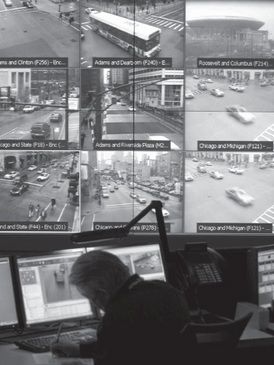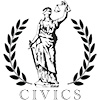| « Chicago Youth Speak About Community Issues in Project Soapbox Citywide Competition | Zoning at 85 and a Reading Assignment » |
Technology and Politics Tue Nov 22 2011
The New Chicago Way: The Wholly Surveilled City
 A friend sent me a note asking if the recent Automated Speed Enforcement system (ASES) approved by the General Assembly at the behest of Chicago's Mayor and Police Superintendent would make Lake Shore Drive fully subject to electronic monitoring, since almost the entire lakefront is a public park, and the bill was pitched as enforcing speed limits near parks and schools, "for the children." The good news is the answer is no, because Lake Shore Drive is exempted from the enacting legislation, known informally as SB956. The bad news is that Lake Shore Drive may be the only unmonitored bit of the city.
A friend sent me a note asking if the recent Automated Speed Enforcement system (ASES) approved by the General Assembly at the behest of Chicago's Mayor and Police Superintendent would make Lake Shore Drive fully subject to electronic monitoring, since almost the entire lakefront is a public park, and the bill was pitched as enforcing speed limits near parks and schools, "for the children." The good news is the answer is no, because Lake Shore Drive is exempted from the enacting legislation, known informally as SB956. The bad news is that Lake Shore Drive may be the only unmonitored bit of the city.
The ASES would not apply to Lake Shore Drive, but it would apply to almost the entire city. Some interesting things about the bill:
First, the way it defines an "automated speed enforcement system." That is as "a photographic device, radar device, laser device, or other electrical or mechanical device or devices installed or utilized in a safety zone and designed to record the speed of a vehicle and obtain a clear photograph or other recorded image of the vehicle and the vehicle's registration plate."
Which brings us pretty seamlessly to "secondly." Secondly, the bill defines a safety zone as any "area" that is within 1/8th of a mile (or a city block) from the property line of any public or private school or school-owned facility except central administrative buildings, and any park district owned property, except, again, for central administrative buildings. As you can imagine (see schools map below) that makes up a huge amount of the city -- because the cut-off isn't just a block. The bill also provides, "However, if any portion of a roadway is within either one-eighth mile radius, the safety zone also shall include the roadway extended to the furthest portion of the next furthest intersection." In other words, if a road falls within the a block of the property line of a school district or park district property, then the "safety zone" is extended to the next intersection, and through it.
Take a look at this map:
These are just the elementary schools.
The other thing is, the Automated Speed Enforcement Systems are not limited to photographic images. They include by implication video cameras: "'Recorded image' means images recorded by an automated speed enforcement system on: (1) 2 or more photographs; (2) 2 or more microphotographs; (3) 2 or more electronic images; or (4) a video recording showing the motor vehicle and, on at least one image or portion of the recording, clearly identifying the registration plate number of the motor vehicle."
Take another look at that elementary school map, throw in the parks and high schools (and facilities owned by the parks department and high schools), and what you've got is a law that allows the City of Chicago to mount video cameras watching practically every inch of the city all the time--not even counting the vast network of police-linked cameras that can track cellphone calls:
"We can now immediately take a look at the crime scene if the 911 caller is in a location within 150 feet of one of our surveillance cameras, even before the first responders arrive," Mr. Orozco said. (via the Chicago News Cooperative)
Supporters of the ASES may respond that the legislation limits the "operation" of these cameras to a specific time frame around the opening and closing of schools and parks. However, the legislation isn't particularly specific about this; it could be liberally construed to mean that it can only operate in the sense that it can only operate for the purpose of recording violations at these times -- the key language below being "operational and violations be recorded":
(a-5) The automated speed enforcement system shall be operational and violations shall be recorded only at the following times: (i) [....] on school days no earlier than 6 a.m. and no later than 10 p.m.; and (ii) [....] no earlier than one hour prior to the time that the facility, area, or land is open to the public or other patrons, and no later than one hour after the facility, area, or land is closed to the public or other patrons.
In any case, for schools that would entail 16 hours of the day, and for many parks as many as 18. If the statute is construed narrowly.
Nor does the statute expressly prohibit any ASES from recording anything other than a license plate, although it says that the cameras must be "designed to" capture license plates -- that it was designed to do that does not mean it cannot do other things, broadly speaking. (Of course, it will be initially cost prohibitive to install more capable cameras.) Thankfully, the statute does prohibit dissemination of images except for the purposes of enforcing civil fines. There is no requirement that images or video be destroyed.
What's distressing is not what the ASES will probably look like initially; it is what this statute, with no need to really amend it, could permit in the near future.
The ACLU has referred to the city's current, vast 10,000+ camera, networked surveillance system as a "pervasive and unregulated threat to our privacy," in a report [PDF] that also quoted former Department of Homeland Security head Michael Chertoff as saying, "I don't think there is another city in the U.S. that has an extensive and integrated camera network as Chicago has."
Some fun facts about what capacities those cameras currently have:
• The cameras have a "pan-tilt-zoom" capacity, meaning operators can increase substantially the size of the captured images.
• The cameras have a "facial recognition" capacity, meaning a computer can automatically search for a particular person's face.
• The cameras have an "automatic tracking" capacity, meaning a computer can automatically track a person or vehicle moving along the public way, jumping from one camera to the next.
As the city responds to the Occupy movement and prepares to host the G8 and NATO next year, do you think it is (a) more likely or (b) less likely that the city, state and federal government (which helped finance the current system) will be expending the money necessary to expand this network to its broadest statutorily permitted limits?
As the ACLU report points out, the money spent on the existing surveillance network could have been spent to fund 1,000 more cops on the street, and has led to only 1 percent of the total arrests in the period of its operation.
It may well be that such a vast network of cameras enforcing red light and speeding infractions will free up police reports dedicated elsewhere. In my experience, pulling people over for speeding or rolling through stale yellow lights is not a high CPD priority as it is; and even if it were a huge time suck, it needs to be measured against the significant loss of privacy that Chicago residents face.
This last point is salient. Consider this from the ACLU report:
[T]he City of Chicago repeatedly has claimed that its camera network effectively deters all manner of crimes. However, when the ACLU pursuant to FOIA probed the City's effectiveness assertions, the City was unable to locate any records that supported its specific public assertions of camera effectiveness. Thus, it is impossible to evaluate whether the City's...assertions are statistically sound...and whether the cameras merely displaced crime to adjacent areas.
That last sentence reminded me of when I was working as an organizer on the city's West Side. The local residents loathed a recently-installed corner camera (a so-called "cop in a box") because while it initially scattered the open-air drug market near Augusta Avenue and Cicero, the dealers regrouped in the two-block area between Augusta and Chicago Ave., pushing rival gang sets closer together.
As with most things, there is not a conspiracy here. What we're looking at is a revenue-generating measure clothed in For The Children PR speak. But like the Panda's Thumb, the granting of power to the state for one purpose can often mutate and be used for other unintended ones.
Technology changes, and democracy must must adapt. But the effortlessness with which governments -- not just the federal government, but our own city and state -- are eliminating the right to privacy and anonymity, and empowering themselves both legally and practically to watch the citizenry the instant they emerge from their homes is troubling. That these changes are made so quickly, and the media so eagerly accept them as necessary to "fight the terrorists" or "protect the children," means precisely that democracy is not adapting. That the state is incorporating technology into its apparatuses of power and the public and the public's watchdogs are doing nothing to realign power and legal regimes to recognize that fact.
Image via the ACLU












Alexandra / November 23, 2011 2:47 PM
Thank you for this piece. Better to consider these realistic threats to privacy before they're made a reality than after.